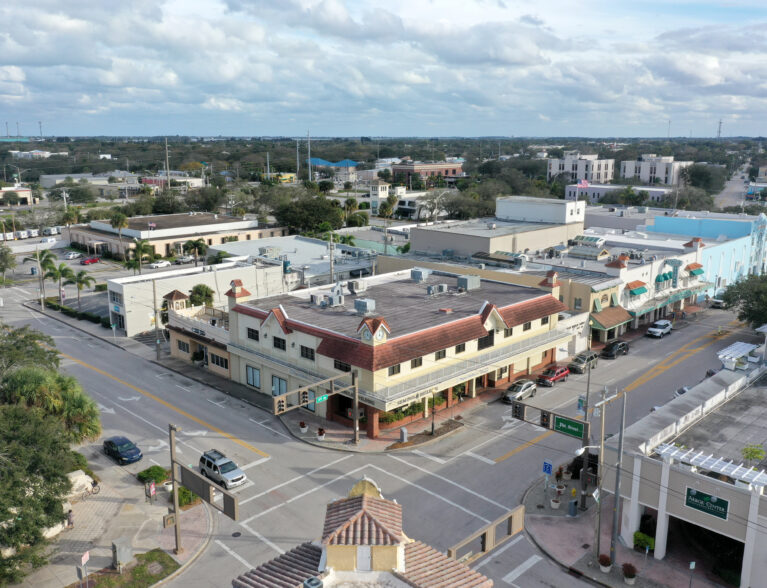
Vero Beach Mayor John Cotugno believes the city has done its part to encourage the further development proponents say must occur to make the downtown more vibrant.
“Now it’s up to the voters,” he said.
The City Council last week approved placing on the Nov. 5 ballot two referendums that, if adopted, would allow the construction of the smaller apartments at the core of its master plan for the revitalization of the downtown area.
One would increase the residential density in the 50-acre downtown core from 17 units per acre to 36 units per acre, with a maximum of 1,800 total units, but retain the district’s 50-foot height limit.
The other would allow building owners to sell already-approved-but-unbuilt units to other property owners, enabling the new owners to build at a higher density, as long as the total number of units stays within the maximum permitted for that area.
The second referendum applies in the sections of downtown zoned for mixed-use development, as well as in the adjacent commercial areas.
City officials and downtown stakeholders say they expect the density-increase referendum to draw the most opposition, citing the fears of “Keep Vero Vero” advocates who already complain about the increased traffic, insufficient infrastructure and overdevelopment they’re seeing throughout the Vero Beach community.
That’s why the council overrode the recommendation of urban planning guru Andres Duany, whose Miami-based DPZ CoDesign firm was hired to create a blueprint for the city’s downtown master plan.
Duany’s recommendation called for the city to allow up to 2,500 total units in the downtown core, increasing the district’s density to 60 units per acre.
“The 60 units per acre and 2,500 total units would’ve been too much,” Cotugno said. “By going to 36 units per acre and 1,800 total units, we can still accomplish our goal – and the referendum has a better chance of being approved by the voters.”
The referendums are the next phase in a process that began last year and began to accelerate in February, when Duany arrived in Vero Beach for a week of downtown reconnaissance.
He made his final presentation to the city in May, unveiling a transformative plan that would dramatically enhance the look and feel of Vero Beach’s urban core by providing the residential development necessary to attract the younger demographic he called the “lifeblood of any downtown.”
In fact, the city’s master plan embraces Duany’s vision of more-affordable studio, one- and two-bedroom apartments, as well as the walkability, nightlife and restaurants he said many young adults are seeking.
The plan initially targets the four blocks along 14th Avenue, between 19th and 23rd streets, and their tributaries. Eventually, though, its reach could extend as far north as the airport, as far south as Vero Beach High School, as far east as the railroad tracks, and as far west as 20th Avenue.
The plan’s fate, however, depends entirely on convincing a majority of city voters to approve the referendums.
County Commission candidate Tracey Zudans, the lone council member to oppose putting the referendums on the ballot, expressed concerns that the city is rushing the process and voters haven’t been sufficiently educated about the plan.
Saying the referendums’ content hasn’t been publicly vetted enough – beyond the downtown business community – and raising questions about possible “financial repercussions” for the city, Zudans urged the council to postpone the ballot initiatives until next year.
The delay would give the city, along with the downtown plan’s backers, the time needed to ease voters’ concerns about increasing residential density and allowing property owners to sell their development rights, she explained.
“From talking to people, my fear is: This isn’t going to pass referendum,” Zudans said during the July 23 meeting, adding that voter rejection would at least temporarily halt the progress the council has made in addressing the downtown area’s future.
The other four council members strongly disagreed, saying the city needed to ride the momentum generated in the months since Duany’s presentation and dismissing Zudans’ contention that the referendums, if approved, could require the city to spend more taxpayer dollars to support its master plan.
None voiced any reluctance in moving forward with both the master plan and the referendums.
“I feel we’ve been pretty thorough,” Vice Mayor Linda Moore said. “Many of the things in this document reflect decades of vision planning for downtown.”
Council member John Carroll echoed her sentiment.
“We’ve spent a lot of time on this – our personal time as well as the public’s time and the staff’s time,” he said. “It’s well vetted. It’s well done.”
Cotugno then refuted any suggestion that the city, which already has spent $400,000 on studies (including another Twin Pairs review) related to downtown revitalization, might need to further invest financially in the project.
“There’s never been any commitment, inferred or direct, from the city for any dollars to be spent, other than investing in a plan and using this plan as a blueprint for downtown, and providing the incentives through the plan,” the mayor said.
He later added: “I think we’ve set the groundwork for a successful public-private partnership. The public part is the plan. The private part is going to be the investment in downtown.”
During the public-comment segment of the meeting, several city residents spoke enthusiastically about the plan and urged the council to go forward with the referendums.
Among them were downtown advocates who offered to engage the community and help promote the referendums in the weeks until Election Day, which is less than 100 days away.
Irina Woelfle, a marketing specialist who runs the LetsTalkVero.com website, said her group – which she claims has the backing of local businessman Tom Corr, realtor T.P. Kenney, and Keith Drewitt of the Clean Water Coalition – can do for the downtown referendum what it for the successful Three Corners ballot initiative two Novembers ago.
“A number of people have come forward to put together a citizen-led campaign to educate the public on the plan,” Woelfle told the council.
Dori Stone, president of the county’s Chamber of Commerce, similarly committed the support of her organization, saying, “We are excited about this plan.”
As for Zudans’ push for a postponement, Mike Johannsen of the Indian River Neighborhood Association echoed the council majority’s belief that there’s no reason to delay.
“We’ve been all over this, all of us together,” Johannsen said. “It’s time to either fish or cut bait. … I think we’re at the point, collectively, to go fishing.
After the meeting, Cotugno defended the council’s vote to let city residents decide in November whether they like what they see in the master plan, but he said it will be up to downtown advocates to sell the referendums to the voters.
“From the city’s standpoint, we’ve done everything we possibly can to foster a public-private partnership and provide the necessary incentives for the development of the downtown district,” the mayor said.
“A lot of work has been put into getting us to this point and, after years in the making, we’ve got a plan in place,” he added. “What we need now is for the stakeholders to get out there and educate the public on what these referendums mean.
“With this being a presidential-election year, we should get a big turnout, which is what you want when you’re putting up a referendum.”
If the referendum fails?
“Then you sit back and reassess,” Cotugno said. “You ask: Did we do something wrong?
What do we need to do differently? What can we do in the meantime that doesn’t require a referendum?”
And if it does pass?
“Then it’s up to the property owners, business owners and developers,” he said. “The city will have done its part.”
Photos by Joshua Kodis







